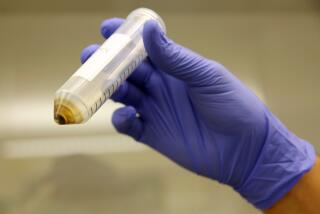Fracking can increase methane in drinking water, study finds
WASHINGTON -- Scientists have found that methane and other gases pose a significant risk of contaminating drinking-water wells near natural gas drilling, raising new questions about possible health and safety risks from the production technique known as fracking.
A study published Monday in the Proceedings of the National Academy of Sciences found that drinking-water wells in northeastern Pennsylvania within a kilometer of high-volume hydraulic fracturing, or fracking, showed methane concentrations six times greater, on average, than in wells farther away.
The gas occurs naturally in the area’s aquifers, but the study showed the chemical composition of methane in wells near the drilling sites is the same as the natural gas extracted in the area.
The researchers tested water samples from wells in six counties where fracking has touched off a natural gas boom. Fracking involves injecting large volumes of water mixed with sand and chemicals at high pressure to shatter rock formations deep underground and unlock oil and gas trapped inside.
Critics have complained that fracking chemicals have fouled some wells, but no studies have shown widespread contamination.
Methane that accumulates in confined spaces such as basements and sheds poses a risk of explosion, but there is little research into the effects on human health of prolonged exposure to methane, said the study’s lead author, Robert B. Jackson, professor of environmental sciences at Duke University.
The study suggested that the methane and other gases associated with fossil fuels ended up in well water because of faulty metal casings inside a well that allow gas to seep out as it travels to the surface. Alternatively, the leaks could be linked to faulty concrete jobs that are supposed to keep gas and water from moving in the space between the well casings and the rock.
The study also found high concentrations of ethane and propane, gases that microbes do not create but are among those in the Marcellus Shale formation.
The fact that methane, ethane and propane were found in so many homes near gas wells points to “problems with multiple independent gas wells,” Jackson said.
The study said, “We need to understand why, in some cases, shale gas extraction contaminates groundwater and how to keep it from happening elsewhere.”
The study was published as several localities across the country battle state leaders about how far natural gas drilling should be set back from homes and schools.
In Pennsylvania, the Legislature passed a law last year that strips localities of authority to zone gas drilling sites farther from residential areas, triggering a lawsuit from several towns.
The study released Monday expands a project, published by Duke researchers two years ago, that the oil and gas industry criticized for testing too few wells, and for failing to account for natural sources of methane in local well water.
This time, the scientists tested 141 wells, up from 60. They tested water from four wells in New York state where no fracking has occurred, and from three different local aquifers.
Methane can be created by microbes or from the same processes that create fossil fuels. The study found that at the 59 homes within a kilometer of a natural gas well, methane levels were on average much higher than those farther away.
Of the 59 homes, a dozen had water wells with methane concentrations greater than 28 milligrams per liter of water, which the Interior Department has identified as the threshold for immediate remediation of a well.
“When the methane concentrations are that high, the water can bubble like champagne,” Jackson said.
Follow Politics Now on Twitter and Facebook
Twitter/@neelaeast
More to Read
Get the L.A. Times Politics newsletter
Deeply reported insights into legislation, politics and policy from Sacramento, Washington and beyond. In your inbox three times per week.
You may occasionally receive promotional content from the Los Angeles Times.







